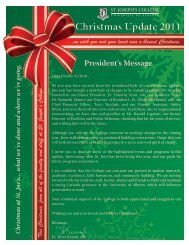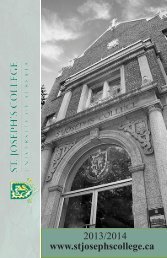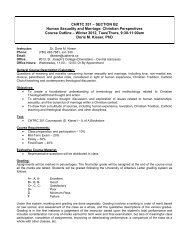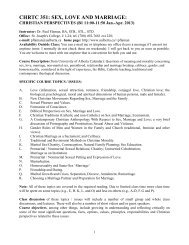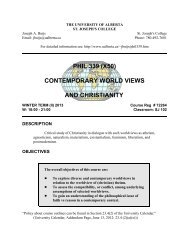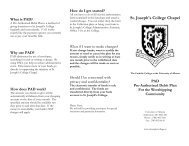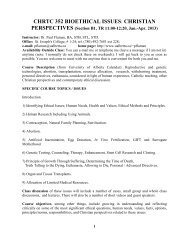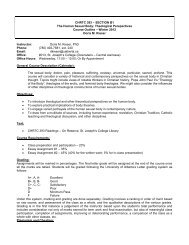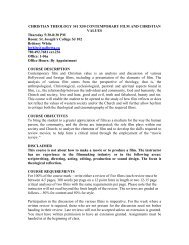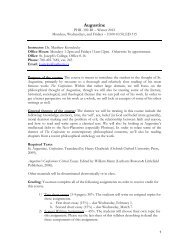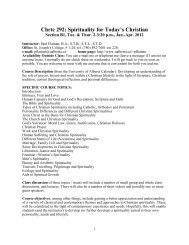chrtc 250:b3 the theological education of the catholic teacher
chrtc 250:b3 the theological education of the catholic teacher
chrtc 250:b3 the theological education of the catholic teacher
Create successful ePaper yourself
Turn your PDF publications into a flip-book with our unique Google optimized e-Paper software.
CHRTC <strong>250</strong>:B3 THE THEOLOGICAL EDUCATION OFTHE CATHOLIC TEACHERWinter Term 2012General Information and RequirementsInstructor: Dr. Robert Sheard Phone: 492-7681Office: St. Joseph's College 1-18E-mail: rsheard@ualberta.caOffice Hours: MTWRF 13:00-13:50 Classroom location: SJC 103or by appointmentClass times TR 09:30-10:50Course DescriptionThis course is intended to provide a knowledge and understanding <strong>of</strong> <strong>the</strong> Catholic faithfor <strong>the</strong> Catholic school <strong>teacher</strong>. It is not a course in methodology, i.e., on how to teach.Topics dealt with include: <strong>the</strong> meaning <strong>of</strong> faith, understanding God, revelation, <strong>the</strong> Bible,<strong>the</strong> nature <strong>of</strong> <strong>the</strong> church, sacraments, and Catholic moral teaching.Course Requirements1. Consistent attendance and participation in class sessions.2. Careful reading <strong>of</strong> <strong>the</strong> reading assignments.3. Successful completion <strong>of</strong> two in-class tests and a final exam.Textbooks1. Knox, Ian. Theology for Teachers. Revised Edition. Ottawa: Novalis, 1999.2. Sheard, Robert B. An Introduction to Christian Belief: A Contemporary Look at <strong>the</strong>Basics <strong>of</strong> Faith. Mystic, CT: Twenty-Third, 1996. [This book is available in “coursepack” form in <strong>the</strong> Bookstore.]Exams and PaperThere will be two in-class tests given during <strong>the</strong> course <strong>of</strong> <strong>the</strong> term and a finalexamination. The dates <strong>of</strong> <strong>the</strong> tests and <strong>the</strong> exam and <strong>the</strong>ir value in terms <strong>of</strong> calculating<strong>the</strong> final grade are as follows.Test #1 (worth 30%) — Monday, February 6Test #2 (worth 30%) — Wednesday, March 14Final exam (worth 40%) — 14:00-16:00 Wednesday, April 25
2Remarks on Grading1. In grading answers to <strong>the</strong> two exams, a "raw score" mark is first given. This is anumber between 0 and 15, with 0 being <strong>the</strong> lowest and 15 being <strong>the</strong> highest possible.A raw score mark <strong>of</strong> 8 is given to answers that one should expect from a normaluniversity student.2. The raw score marks assigned to each answer <strong>of</strong> an exam are totaled and this totalis converted into a letter-grade/percentage mark. See <strong>the</strong> Table below for <strong>the</strong>conversions and interpretation <strong>of</strong> <strong>the</strong> letter-grades.3. At <strong>the</strong> end <strong>of</strong> <strong>the</strong> term, a final letter-grade/percentage mark will be calculatedaccording to <strong>the</strong> weight given to each exam and to <strong>the</strong> paper. It is important to note,however, that <strong>the</strong> final grade may not necessarily be based on <strong>the</strong> ma<strong>the</strong>maticalcalculation <strong>of</strong> grades received on <strong>the</strong> two exams and <strong>the</strong> paper. O<strong>the</strong>r factors, such asclass participation and improvement during <strong>the</strong> term may affect <strong>the</strong> final mark.Table for Converting Raw Score Marks into Letter Grade and Percentage Marks45 A+ 100 Exceptional 26 C+ 69 Good44 A+ 95-99 25 C+ 6843 A+ 93-94 24 C+ 6742 A+ 90-9223 C 66 Satisfactory41 A 89 Excellent 22 C 6540 A 87-88 21 C 6439 A 8638 A 85 20 C- 6319 C- 6237 A- 82-84 18 C- 60-6136 A- 80-8117 D+ 59 Pass35 B+ 79 Very Good 16 D+ 5834 B+ 78 15 D+ 5733 B+ 7714 D 5632 B 76 13 D 5531 B 75 12 D 5430 B 7411 D- 53 Unsatisfactory29 B- 73 Good 10 D- 5228 B- 72 9 D- 50-5127 B- 70-71
3Course outline policy:“Policy about course outlines can be found in ' 23.4(2) <strong>of</strong> <strong>the</strong> University Calendar.”(GFC 29 SEP 2003).“The University <strong>of</strong> Alberta is committed to <strong>the</strong> highest standards <strong>of</strong> academicintegrity and honesty. Students are expected to be familiar with <strong>the</strong>sestandards regarding academic honesty and to uphold <strong>the</strong> policies <strong>of</strong> <strong>the</strong>University in this respect. Students are particularly urged to familiarize<strong>the</strong>mselves with <strong>the</strong> provisions <strong>of</strong> <strong>the</strong> Code <strong>of</strong> Student Behaviour (online atwww.ualberta.ca/secretariat/appeals.htm) and avoid any behaviour whichcould potentially result in suspicions <strong>of</strong> cheating, plagiarism,misrepresentation <strong>of</strong> facts and/or participation in an <strong>of</strong>fence. Academicdishonesty is a serious <strong>of</strong>fence and can result in suspension or expulsion from<strong>the</strong> University.” (GFC 29 SEP 2003)In resolving any discrepancy between this course outline, syllabus or course website,GFC policy and Calendar regulations will take precedence. (GFC 29 SEP2003)Academic OffencesBecause <strong>of</strong> <strong>the</strong> seriousness <strong>of</strong> plagiarism and cheating, please note <strong>the</strong> definitions <strong>of</strong>cheating and plagiarism and <strong>the</strong> related penalties. The Code <strong>of</strong> Student Behaviour ispublished in <strong>the</strong> Calendar (pages 743-763) and should be reviewed since ignorance is notacceptable as a defence in cases <strong>of</strong> academic <strong>of</strong>fences. When cheating and/or plagiarismoccurs, a number <strong>of</strong> sanctions can be imposed, such as lowering a grade or expulsionfrom <strong>the</strong> University (outlined in Section 30.4.2 <strong>of</strong> <strong>the</strong> Code). Academic integrity isimportant. In examinations, it is particularly important to note that texts and notes arenot permitted in places that might promote cheating.Please note Section 30.3.2 in “Extract from <strong>the</strong> Code <strong>of</strong> Student Behaviour” is availablefrom <strong>the</strong> GFC Policy Manual and <strong>the</strong> copy <strong>of</strong> “Notice to Instructors regarding Plagiarismand Cheating (Cheatsheet)” is available at http://www.ualberta.ca/secretariat entitled“Don’t Cheat Sheet”.. A copy <strong>of</strong> <strong>the</strong> Code <strong>of</strong> Student Behaviour may be obtained from<strong>the</strong> University Secretariat web site: http://www.ualberta.ca/secretariat.In particular, please note:No student shall represent ano<strong>the</strong>r’s substantial editorial or compositional assistance onan assignment as <strong>the</strong>ir own.No student shall submit in any course or program <strong>of</strong> study, without <strong>the</strong> written approval<strong>of</strong> <strong>the</strong> course instructor, all or a substantial portion <strong>of</strong> any academic writing, essay, <strong>the</strong>sis,research report, project assignment, presentation or poster for which credit has beenobtained by <strong>the</strong> Student or which has previously been or is being submitted by <strong>the</strong>Student in ano<strong>the</strong>r course or program <strong>of</strong> study in <strong>the</strong> University or elsewhere.
4COURSE OUTLINE AND READINGSINTRODUCTIONPART ONE. FOUNDATIONS: FAITH AND GOD1. Towards An Understanding <strong>of</strong> Religious FaithReading: Theology for Teachers, chs. 1, 2, 5Introduction to Christian Belief, ch. 1.2. Towards An Understanding <strong>of</strong> GodReading: Theology for Teachers, chs. 3 & 4.Introduction to Christian Belief, ch. 2.PART TWO. FOUNDATIONS: REVELATION, SCRIPTURE, AND TRADITION3. Revelation: Our Contact With GodReading: Theology for Teachers, ch. 6.Introduction to Christian Belief, ch. 3.4. God’s Word in Scripture And TraditionReading: Theology for Teachers, ch. 7.Introduction to Christian Belief, chs. 4 & 5.5. The Old TestamentReading: Theology for Teachers, chs. 8 & 9.6. The New TestamentReading: Theology for Teachers, ch. 10.PART THREE. TOWARDS AN UNDERSTANDING OF JESUS7. Understanding Jesus <strong>of</strong> NazarethReading: Theology for Teachers, ch. 11.Introduction to Christian Belief, chs. 10. 11, 12, 13, 14, & 15.PART FOUR. CHURCH AND SACRAMENT8. Towards an Understanding <strong>of</strong> <strong>the</strong> ChurchReading: Theology for Teachers, chs. 12 & 13.
59. Sacramentality and SacramentsReading: Theology for Teachers, chs. 14, 15, 16.PART FIVE. CHRISTIAN MORAL LIVING10. MoralityReading: Theology for Teachers, ch. 17.11. Towards An Understanding <strong>of</strong> SinReading: Theology for Teachers, chs. 18, 20, 21.Introduction to Christian Belief, ch. 9.PART SIX. THE LAST THINGS12. Heaven, Hell, and PurgatoryReading: Theology for Teachers, ch. 22.Reason, Faith, and Tradition, ch. 7.Mosaic, near Trevi, Italy



